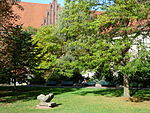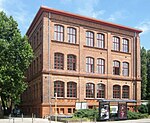Heinrich-Heine-Straße (Berlin U-Bahn)
Berlin U-Bahn stationsBuildings and structures in MitteHeinrich HeineRailway stations in Germany opened in 1928

Heinrich-Heine-Straße is a Berlin U-Bahn station on the , located under the street of the same name in Mitte, and protected as an architectural landmark. The street and the station were called Neanderstraße until 1960.
Excerpt from the Wikipedia article Heinrich-Heine-Straße (Berlin U-Bahn) (License: CC BY-SA 3.0, Authors, Images).Heinrich-Heine-Straße (Berlin U-Bahn)
Heinrich-Heine-Straße, Berlin Mitte
Geographical coordinates (GPS) Address Nearby Places Show on map
Geographical coordinates (GPS)
| Latitude | Longitude |
|---|---|
| N 52.510277777778 ° | E 13.415833333333 ° |
Address
U Heinrich-Heine-Straße
Heinrich-Heine-Straße
10179 Berlin, Mitte
Germany
Open on Google Maps








